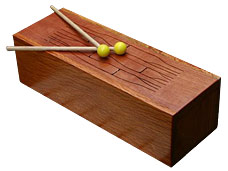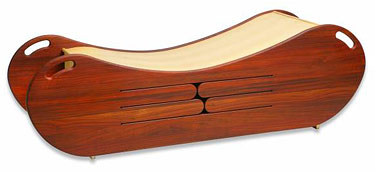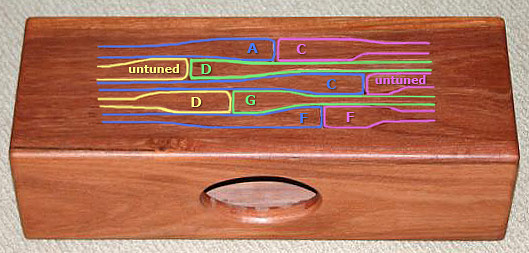

|
Drum Kit Home
Tongue DrumsThe BasicsSize Construction Tuning Wood Types Rubber Feet Sticks |

Photo courtesy of Robert Towler |

Photo courtesy of Robert Towler |
|
The Basics Tongue drums are simple, wooden drums where hitting each "tongue" produces a different pitch - somewhat like a marimba. Scally: It takes a couple of hours to cut all the parts and jig saw the tongues. The cut edges of the tongues need sanding and that is a steady job. I use strips of belt sander paper because it is tough and flexible. Then glue it up. Next day you can sand and put the finish on. The sticks take 10 minutes. Drill a hole half way through a superball - drop in a drop or two of Superglue - slide in the length of dowel - spay on accelerator and you are done. |
|
Size Robert Towler: All boards are thicknessed to 20mm. Less than that and the tongues vibrate against each other. Width 170mm All long boards are 450mm long by 130mm wide. The end boards are 90mm high by 130mm wide. Total width is 170mm (130mm width of top or bottom plus 20mm thickness each front and back). Approximate inch measurements: They are all about 14" long and 5" wide by 5" high. All boards are around 3/4" thick. |
 |
|
Construction The joints are all butt joints with dowels and glue. |
|
Tuning My drum was tuned and has held the tuning for several years. Some of the tongues have had timber removed from the underside, near the tips to refine the tuning. The tuning for the bottom drum is: Key of F Starting from the Top Left A / C (short tongue is untuned) / D C ( short untuned) D / G F / F at the bottom left |
 |
|
Wood Types The timbers are Australian dense hardwoods - Bluegum Tasmanian blackwood Jarrah and Forest Oak. Rubber Feet Robert Towler: The rubber feet improve the sound dramatically. Sticks The sticks are Superballs glued onto small dowel. |